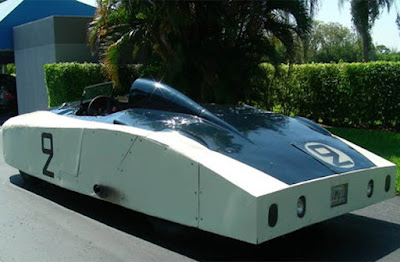2 in 1 - As the 1970s drew to a close, Maserati found itself at a crossroads, mirroring the uncertainties that marked the beginning of the decade. The Italian automaker was navigating the challenges of its recent acquisition by the De Tomaso motor company. Burdened by a staggering debt of 4 billion Lira (equivalent to US$20 million today), Maserati faced operational hurdles that seemed insurmountable.
 |
| The Maserati 330 Ricarrozata Berlinetta was a remarkable project emerged to commemorate Maserati's golden years in racing, and crafted by the Italian design firm ATL in 1979. (Picture from: YourSydneyMate) |
 Under the leadership of Alejandro De Tomaso, a relentless effort was made to purge any remnants of Citroën, the previous owner, from Maserati's identity. This overhaul included abandoning vehicles heavily reliant on French components and replacing Citroën parts with standard alternatives. Even a joint Citroën/Maserati V6 engine, previously developed and shelved, was entirely scrapped. In a bold move, engineers with any affiliations to the French company, including the longtime chief engineer Giulio Alfieri, were unceremoniously ousted on De Tomaso's inaugural day.
Under the leadership of Alejandro De Tomaso, a relentless effort was made to purge any remnants of Citroën, the previous owner, from Maserati's identity. This overhaul included abandoning vehicles heavily reliant on French components and replacing Citroën parts with standard alternatives. Even a joint Citroën/Maserati V6 engine, previously developed and shelved, was entirely scrapped. In a bold move, engineers with any affiliations to the French company, including the longtime chief engineer Giulio Alfieri, were unceremoniously ousted on De Tomaso's inaugural day. |
| The Maserati 330 Ricarrozata Berlinetta painted in a distinctive racing green, the body paid homage to Maserati racers from the 1950s and 60s. (Picture from: YourSydneyMate) |
De Tomaso's vision for Maserati aimed at transforming the brand's image from a high-end, high-performance luxury item to something more accessible to the average Italian. The goal was to create family-oriented vehicles, providing an opportunity for the common man to own a Maserati. Despite the challenges, De Tomaso's strategic decisions kept Maserati afloat and still producing vehicles, albeit in a different direction.
 |
| The Maserati 330 Ricarrozata Berlinetta boasted a full aluminum body, blending elements from two iconic racers: the Maserati A6GCS/53 and the Maserati 450S, resulting in a visually stunning sports coupe. (Picture from: YourSydneyMate) |
Amidst the turmoil of this period, particularly in 1979, Maserati unveiled several aesthetically pleasing and unique models such as the Maserati Merak, Maserati Kyalami, Maserati Quattroporte, and the spotlight of our discussion, the Maserati 330 Ricarrozata Berlinetta.
In 1979, a remarkable project emerged to commemorate Maserati's golden years in racing—the Maserati 330 Ricarrozata Berlinetta. Crafted by the Italian design firm ATL, this special vehicle boasted a full aluminum body, blending elements from two iconic racers: the PininFarina-designed A6GCS/53 and the Zagato-made 450S, resulting in a visually stunning sports coupe.
 |
| The Maserati 330 Ricarrozata Berlinetta powered by a 4.2-liter dual overhead cam V8 engine borrowed from the Kyalami to generate 255 bhp at 6,000 rpm and 260 lb-ft of torque at 3,200 rpm. (Picture from: YourSydneyMate) |
Powered by a 4.2-liter dual overhead cam V8 engine borrowed from the Kyalami, the two-seater coupe generated 255 bhp at 6,000 rpm and 260 lb-ft of torque at 3,200 rpm. A five-speed manual transmission completed the powertrain, delivering a thrilling rear-wheel-drive experience. Painted in a distinctive racing green, the body paid homage to Maserati racers from the 1950s and 60s.
 While the 1970s presented numerous obstacles for Maserati, the tail end of the decade brought a semblance of stability, even as the brand's reputation suffered due to quality concerns. Despite this, Maserati's commitment to delivering impressive engine performance and driving experiences remained unwavering. As the tumultuous decade concluded, Maserati stood resilient, ready to face the challenges of the next era in its storied history. *** [EKA | FROM VARIOUS SOURCES | YOURSYDNEYMATE ]
While the 1970s presented numerous obstacles for Maserati, the tail end of the decade brought a semblance of stability, even as the brand's reputation suffered due to quality concerns. Despite this, Maserati's commitment to delivering impressive engine performance and driving experiences remained unwavering. As the tumultuous decade concluded, Maserati stood resilient, ready to face the challenges of the next era in its storied history. *** [EKA | FROM VARIOUS SOURCES | YOURSYDNEYMATE ]Note: This blog can be accessed via your smart phone.
































